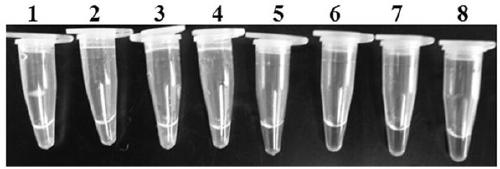Lamp primer composition and application for detecting tomato infestans
A technology of tomato late blight bacteria and primer composition, which is applied in the directions of biochemical equipment and methods, recombinant DNA technology, and microbial determination/inspection, and can solve the problems of low accuracy, long detection time, long time consumption, etc., and achieve results. Reliable, sensitive and specific results
- Summary
- Abstract
- Description
- Claims
- Application Information
AI Technical Summary
Problems solved by technology
Method used
Image
Examples
Embodiment 1
[0029] Example 1: Design of specific primer composition and primer specificity verification for loop-mediated isothermal amplification (LAMP) detection of tomato infestans
[0030] 1. Extraction of genomic DNA of the tested strains
[0031] The genomic DNA of the tested strains (Table 1) was extracted by the CTAB method. The specific method is as follows: Take a small amount of mycelium powder in a 1.5mL centrifuge tube (it is better that the mycelium powder just covers the bottom of the semicircle), add 900 µL of 2% CTAB ( cetyltrimethylammonium bromide) extract (2% CTAB; 100 mmol / L Tris-HCl, pH 8.0; 20 mmol / L EDTA, pH 8.0; 1.4 mol / LNaCl) and 90 µL SDS (ten Sodium dialkylbenzene sulfonate) [Note: CTAB, SDS needs to be preheated at 60°C], use a shaker to shake and mix, 60°C water bath for 1h (DNA is released into the buffer), 12000 r min -1 Centrifuge for 15 min; take 700 µL of the supernatant, add an equal volume of phenol, chloroform, isoamyl alcohol mixture (volume ratio 2...
Embodiment 2
[0042] Example 2: Detection Sensitivity of Loop-Mediated Isothermal Amplification (LAMP) for Tomato Infestans Infestans
[0043] 1. Preparation of genomic DNA at different concentrations
[0044] Dilute the genome DNA of Phytophthora infestans with sterile ultrapure water, and prepare a series concentration of 10 times order of magnitude for later use;
[0045] 2. Sensitivity determination and result observation of LAMP detection method
[0046] Genomic DNA of Phytophthora infestans at different concentrations was used as a template, and the outer primers F3 / B3 and inner primers FIP / BIP were used for LAMP amplification. The LAMP detection reaction system was 25 μL, including 5 μM outer primers F3 and 1.0 μL each of B3, 1.0 μL each of 40 μM inner primers FIP and BIP, LAMP reaction mixture [40 mM Tris-HCl, 20 mM (NH 4 ) 2 SO 4 , 20 mM KCl, 16 mM MgSO 4 , 1.6 mol / L Betaine (Betaine), 2.0 mM dNTPs, 0.2% Trion X-100] 12.5 μL, 8 U Bst 1.0 μL of polymerase, 1.0 μL of DNA templat...
Embodiment 3
[0049] Example 3: LAMP detection of tomato infestans in pathogenic tissue
[0050] Sample collection: Collect tomato late blight symptoms and healthy leaves from Zhouning, Sanming, and Liancheng in Fujian and bring them back to the laboratory for later use;
[0051] Plant tissue DNA extraction: DNA was extracted by NaOH rapid cleavage method, the specific process is as follows: add 10µL 0.5 mol / L NaOH to each mg of plant tissue, fully grind the tissue into a paste in a mortar and transfer it to a 1.5mL centrifuge tube centrifuge at 12,000 rpm for 6 min, take 5 µL of the supernatant and add 495 µL 0.1 mol / L Tris-HCl (pH=8.0) to mix well, and take 1.0 µL as a PCR template for amplification.
[0052] LAMP amplification detection and observation: Using the above-mentioned extracted DNA as a template, use the outer primer F3 / B3 and inner primer FIP / BIP for LAMP amplification. The LAMP detection reaction system is 25 μL, including 5 μM outer primer F3 and 1.0 μM each for B3. μL, 1....
PUM
| Property | Measurement | Unit |
|---|---|---|
| Sensitivity | aaaaa | aaaaa |
Abstract
Description
Claims
Application Information
 Login to View More
Login to View More - R&D
- Intellectual Property
- Life Sciences
- Materials
- Tech Scout
- Unparalleled Data Quality
- Higher Quality Content
- 60% Fewer Hallucinations
Browse by: Latest US Patents, China's latest patents, Technical Efficacy Thesaurus, Application Domain, Technology Topic, Popular Technical Reports.
© 2025 PatSnap. All rights reserved.Legal|Privacy policy|Modern Slavery Act Transparency Statement|Sitemap|About US| Contact US: help@patsnap.com



